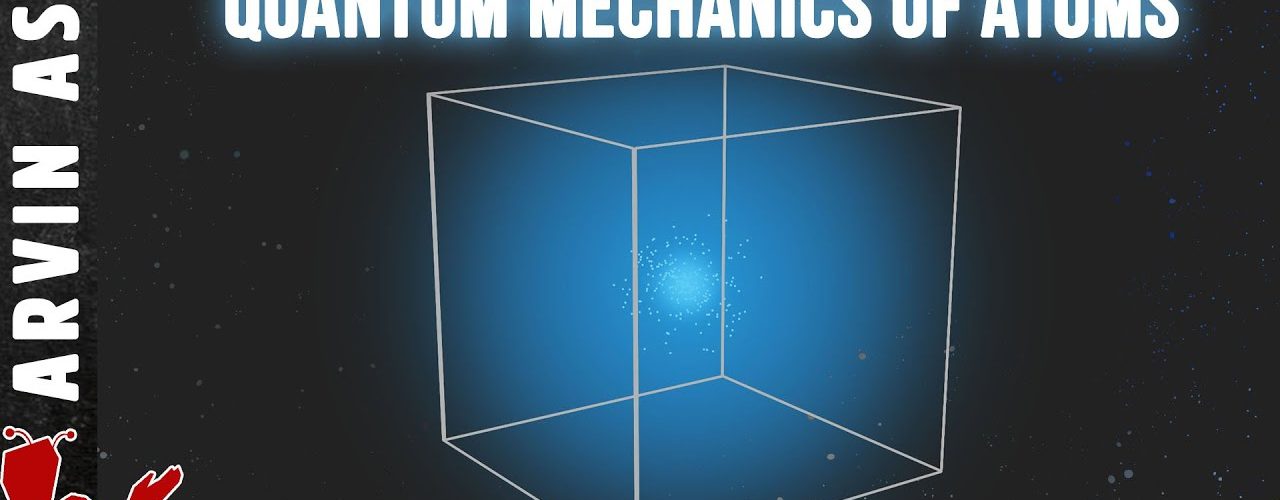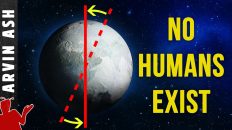Once in a while a great scientist comes along who notices a pattern in nature that others may have completely missed. For example, Isaac Newton realized that the forces acting on a fired cannonball are the same as that on the moon orbiting the earth.
Ernest Rutherford was another such person. When he realized that atoms have a heavy nucleus, he hypothesized that the way the moon orbits earth is the same as the way an electron orbits the nucleus of atoms.
Newton was right. Rutherford we now know was wrong. An atom would not look anything like this. Yet we still use the Rutherford model to depict the way atoms look. It is the most familiar image we have of the atom.
A real atom would look shockingly different from anything like this. And it would definitely not be mostly empty space as you’ve been told.
What does an atom really look like? And how did we determine that? Why doesn’t an electron fall onto the nucleus if they attract each other so strongly? Why can’t you squeeze an atom? The answer requires us to look deeper into the meaning of quantum mechanics. Why do we trust quantum mechanics anyway? And did we arrive at this revelation – perhaps the most accurate and proven theory in science.
In 1911, Ernest Rutherford proposed a planetary model of the atom. According to the model, the solar system and the atom were almost identical.
Just like the moon is held in orbit around the earth due to gravity, the negatively charged electron was held in orbit around a positively charged nucleus. The attractive force was electromagnetism instead of gravity in the case of the atom.
This seemed to make sense because Isaac Newton’s law of universal gravitation was almost identical to coulomb’s law for electric force. This was beautiful. A fantastic symmetry of nature.
But alas, it was too good to be true. One big problem is that when electrons are accelerated, as they would be when constantly changing direction traveling in circular orbits, they create electromagnetic waves according to Maxwell’s equations. This means that photons would be constantly radiated from the electron, causing it to lose energy.
It would radiate a rainbow of colors, getting bluer and more purplish as the electron came closer and closer to the nucleus, until it collapsed into it.
So using Classical laws for the atom just did not work if you presume the Rutherford model.
A bold new step was needed, but little did Rutherford realize that 11 years earlier, in 1900, Max Planck had already made this step, by showing that energy of photons was quantized. Planck’s theory had shown that matter emitted only discrete amounts of radiation, with energy E proportional to the frequency f – the proportionality constant h, being Planck’s constant.
A Young scientist by the name of Neil’s Bohr came along and combined Rutherford’s model and Planck’s theory to hypothesize that the electron could exist in certain special orbits without radiating energy.
What Bohr noticed is that Planck’s constant had units of angular momentum. So he hypothesized that only those orbits would be allowed where the angular momentum of the electron is quantized based on Planck’s constant. And he guessed that the lowest orbit would have the momentum h/2pi where the 2pi comes from the geometry of circular orbits. And any orbit could exist as long as it was an integer multiple of this number. So the next orbit would be 2 x h/2pi. Then 3X for the next one and so on. (Angular Momentum = L = mvr) (h = 6.6 x 10^-34 joule-seconds or kg m^2/sec)
And Bohr predicted that the electrons would only radiate or absorb energy when these electrons jumped from one orbit to another.
But Bohr could not explain why electrons would not emit photons all the time, or why these special orbits should exist in the first place.
But presuming he was right, you could find the size of the orbit of the electron using coulomb’s law. It turns out that the radius of the lowest orbit would be .529 X 10^-10 m, about half an angstrom. So now we knew the size of the atom, which had been a mystery in the past.
Knowing this, the energy emitted by the electron as it changes orbits could be calculated. Lo and behold, observations of energy emissions, confirmed these calculations. So Bohr’s model was right.
Since this model predicted values that could be verified, it was thought that this is it – this must be what atoms really look like. The problem was no one knew why Bohr was right. So this was probably not the final answer.
Then along came brilliant French scientist, Louis de Broglie. He said look if a particle has a momentum and it has a wavelength associated with it because of Planck’s constant, then an electron is probably a wave. This required a huge philosophical leap, because here was a guy suggesting that solid matter – things that we can see and feel on a macro scale were composed of waves. Matter was somehow a particle and a wave at the same time. This seemed logical but no one knew how this could be.
De Broglie suggested that electrons can only exist in orbits where their waves interfere constructively, and that can only happen if the circumference of the orbit is equal to the wavelength, or twice the wavelength or 3 times the wavelength or any integer times the wavelength. This made sense, and explained why orbits would be at the radii that they are, something that Bohr could not do.
The Bohr model was looking more and more legit. But there were still many questions. What is the nature of these waves? How and why do they exist?
A crucial piece of the puzzle was solved by Austrian physicist, Erwin Schrodinger. He said look guys, if it’s a wave, it can exist anywhere in 3 dimensional space. And he formulated the rules to describe the behavior of these waves. The rules are encompassed in the Schrodinger equation, which became arguably the most important equation in quantum mechanics.
The rules were so spectacularly successful in making predictions that no one could really dispute it. Schrodinger’s equation could describe the hydrogen atom with more detail and precision than the Bohr model. And it could also describe all the other atoms in the periodic table, which the Bohr model could not. It was a revelation.
This was not Newtonian mechanics any more, but a new kind of mechanics based on the quantum revolution started by Max Planck. It was quantum mechanics.
And Schrodinger’s equation containing the wave functions of atoms is the one critical piece of information that we need to determine what an atom most likely looks like.
But why do we even have to guess. Why don’t we settle the debate by just looking inside any material to see what these pesky little things actually look like?
The problem is that in order to be seen, the object has to be large enough to reflect light. But the largest atom is 1000 times smaller than a wavelength of visible light. So visible light just goes right through the atoms – it can’t really be seen because no light is reflected back.
What about using shorter wavelength light, like X-rays? The problem is that short wavelength light carries so much energy, that it interacts with the electron, changing it.
This is one consequence of Heisenberg’s Uncertainty Principle, which says that the range of an electrons position times the range of its momentum can not be below a certain constant – h over 4Pi. We cannot say where the electrons are and how fast they are moving at the same time, so we can’t draw a picture with a little electron in one place sitting on a circular orbit.
So we have to take our best guess based on what the wave equation tells us. And what it tells us is that the electron forms a cloud around the nucleus. The shape of the cloud is governed by the wave function. It is called a wave function because the quantum wave equation resembles the equation for classical waves.
The cloud represents the probable position of the electron if you were to measure it. And this cloud exists everywhere from the nucleus to far away from the nucleus. The volume of the atom is thus definitely not empty. It is filled everywhere with a cloud of electrons.
We can use the Schrodinger wave equation to find the electron probability. This plot shows the probability of finding the electron at various distances from the nucleus for a hydrogen atom. The highest probability occurs at, wouldn’t you know it, 0.529 X 10^-10 meters, which is exactly the radius calculated by Bohr. So the most probable radius obtained from quantum mechanics is identical to the radius calculated by classical mechanics.
In Bohr’s model, however, the electron was assumed to be at this distance all the time, whereas in the Schrödinger model, it is at this distance only some of the time. It has the highest probability of being at this radius, but it could be elsewhere too. The difference is due to the Heisenberg uncertainty principle, and the fact that electron acts like a 3D wave.
And the same wave equation tells us that the nucleus of atoms, which in the case of the Hydrogen atom is a proton, is also a cloud. But the extent of the proton cloud is much smaller than the electron cloud because it is much more massive.
So if you look at the uncertainty equation, you can see that the extent of the delta x would be much smaller, given a large m, in order to satisfy the inequality.
The proton cloud is so small in fact, that if the electron cloud was the size of Michigan stadium, the largest sports stadium in America, which seats about 110 thousand people, the proton cloud would be the size of a marble at the 50 yard line. The electron could is about 100,000 times larger.
So the idea of discrete spherical protons and neutrons in the nucleus, or electrons orbiting them is really fiction. It is good for showing to kids in class rooms, but not for students of quantum mechanics.
Let me clarify though that you could never actually see a hydrogen atom in this state because the act of seeing it would necessarily change it, but if by some magic you could see its state without measuring it, this is a good approximation.
Note that there are other shapes that the cloud of the hydrogen atoms could take as well depending on the energy level and quantum state of the electron.
But here are actual images of a hydrogen atoms taken by an international team of researchers in 2013. How can this be given what just told you about not being able to see atoms? Well, this is not a direct image. If you read their paper, you will find that it is a composite image based on the trajectory of electrons emitted by hundreds of hydrogen atoms after they are excited by laser pulses.
So now we can answer our original 2 questions – First why doesn’t the electron just fall to the proton in the nucleus if it is attracted to it. After all if you drop a meteor directly onto the earth with no angular momentum, it will hit the earth with a colossal amount of energy, enough to kill all the dinosaurs.
But when it comes to the atom, even if you drop an electron with no angular momentum directly onto a proton, the electron will not fall and hit the proton. Why? Because if it did, it would violate the Heisenberg uncertainty equation because both delta X and delta P would be zero. This can not be. What happens is that there will always be a balance between the position and momentum of the electron such that the uncertainty principle is obeyed. What happens is that the electron forms a cloud around the proton.
You might say ok, I get that, but if it is a cloud, why can’t I squeeze two atoms together.
We have to go to a chart which shows the energy of the electron as a function of distance from the nucleus. The electron prefers to be in its lowest energy state which is at a distance .529X10^-10 meters from the nucleus. In order to squeeze atoms to a smaller size, we have to increase the energy of the electron. This requires the electron to go to a higher energy state. When you consider that there are quadrillions + atoms in any object we can see. For example a grain of sand has about 10^18 atoms, the cumulative amount of energy is humongous – on the order of energies expended in a small atomic bomb blast. And this is the reason we have solid objects that we can hold in our hand without our hand being able to squeeze them to nothing, and why we don’t sink if we stand on solid ground.
So while quantum mechanics results in some very mysterious phenomenon that we have a hard time explaining, like the double slit experiment, or entanglement, it also gives us a deeper and more complete picture of reality as it probably actually is. So while you might feel uncomfortable with quantum mechanics because of it unintuitive nature, remember that nature has no obligation to be intuitive or understood by us conceited hairless apes, who think we deserve to know the deepest secrets of the universe.







